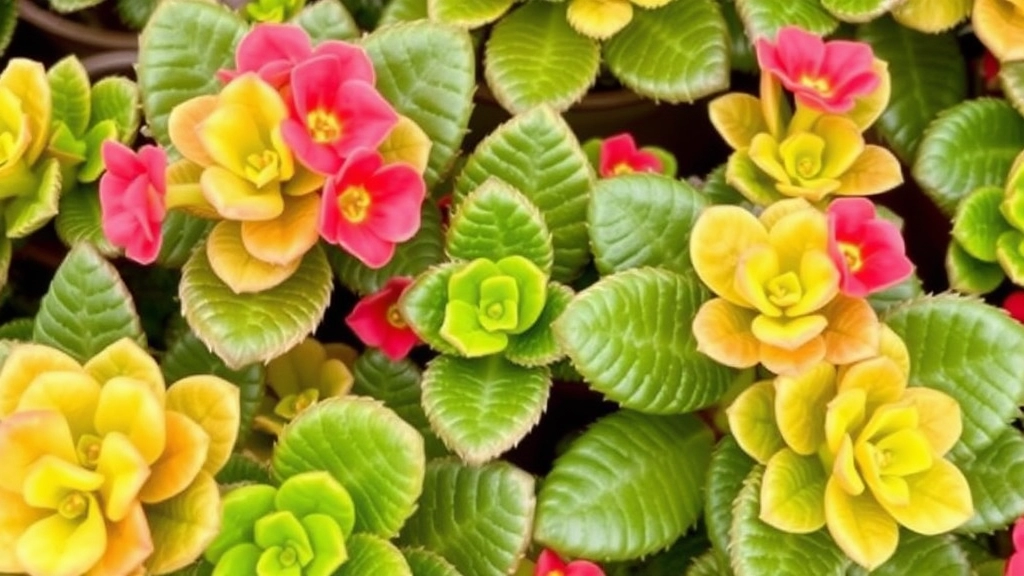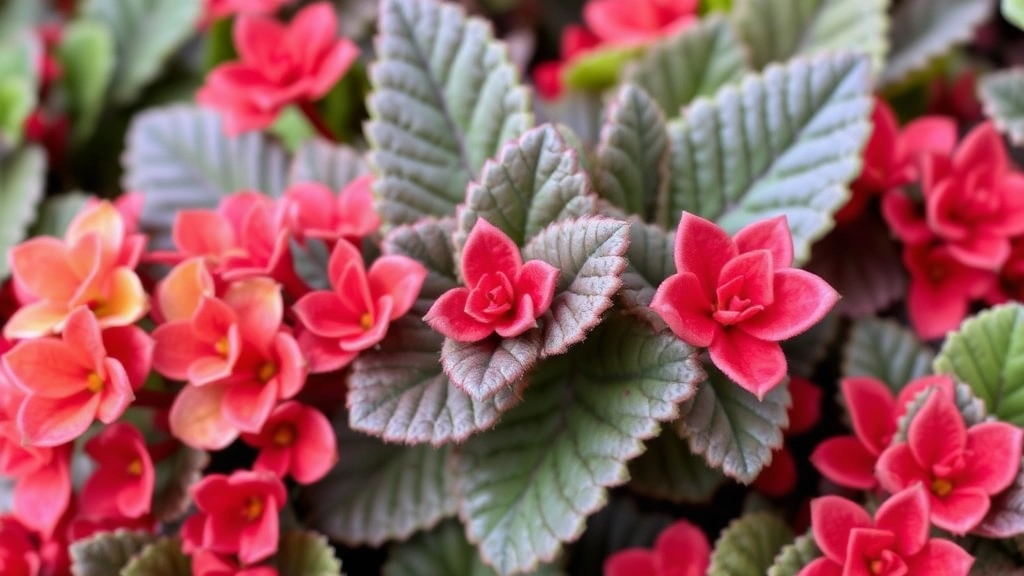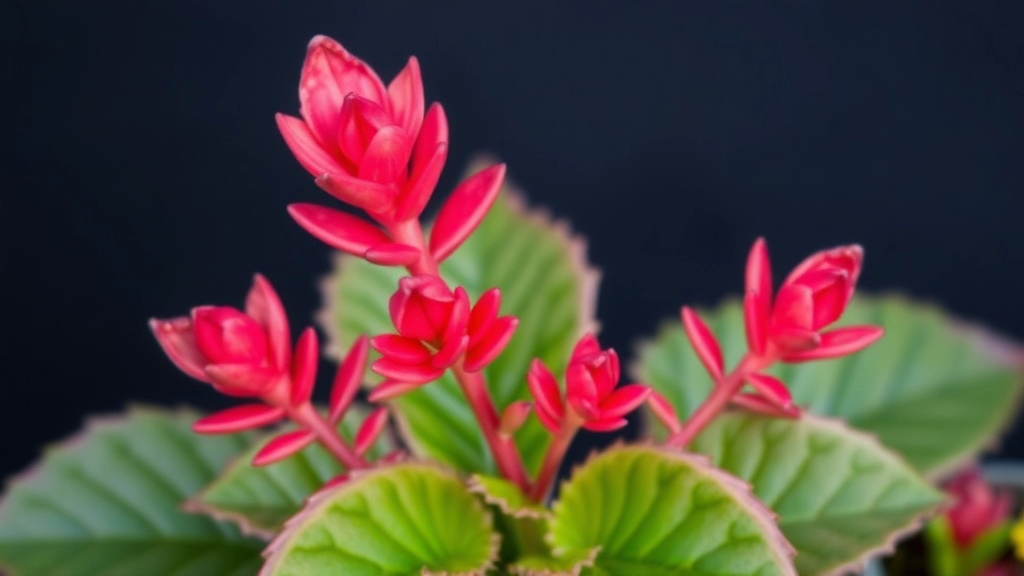Kalanchoe Leaf Discoloration
Ever noticed your Kalanchoe leaves turning red and wondered why? You’re not alone. Many plant enthusiasts face this issue, and it often boils down to a few common factors. Overexposure to sunlight, improper watering, and temperature stress are usually the main culprits. Understanding these causes can help you take better care of your Kalanchoe and restore its vibrant green colour.
Common Causes of Leaf Discoloration
Sunlight is essential for Kalanchoe, but too much can lead to reddening leaves. Similarly, watering mistakes, whether it’s too much or too little, can stress the plant and cause discolouration. Temperature fluctuations also play a significant role in the health of your Kalanchoe.
Tips for Care
- Monitor sunlight exposure
- Check watering frequency
- Avoid temperature extremes
By identifying and correcting these issues, you can ensure your plant thrives and remains healthy.
Common Reasons for Kalanchoe Leaves Turning Red
Are you noticing your Kalanchoe leaves turning red? This can be concerning for any plant enthusiast.
Several factors can contribute to this change in colour, and understanding them is crucial for maintaining a healthy plant.
1. Sunlight Exposure
One of the most common reasons for Kalanchoe leaves turning red is overexposure to sunlight.
While these plants thrive in bright light, too much direct sunlight can cause stress, leading to a reddish hue.
2. Watering Practices
Improper watering can also play a significant role.
Both overwatering and underwatering can result in stress, which may manifest as red leaves. For more detailed tips, check out our guide on fixing drooping Kalanchoe leaves.
3. Temperature Fluctuations
Temperature stress is another factor to consider.
Kalanchoe prefers a stable environment, and extreme temperatures can lead to leaf discolouration.
4. Soil Quality and Nutrient Deficiency
The quality of the soil and nutrient levels can’t be overlooked.
Poor soil conditions can contribute to nutrient deficiencies, resulting in changes in leaf colour. For more on soil and nutrient care, visit our page on brown spots on Kalanchoe leaves.
5. Overfertilization
Interestingly, overfertilisation can also lead to red leaves.
Excess nutrients can create imbalances, stressing the plant and affecting its appearance.
How Overexposure to Sunlight Affects Kalanchoe Color

Ever looked at your Kalanchoe and thought, “Why are my leaves turning red?” You’re not alone! One of the most common culprits is overexposure to sunlight.
Kalanchoe plants love the sun, but too much of it can be a real problem. When they soak up more sunlight than they can handle, the leaves start to change colour, often turning a striking red. This can be alarming, but it’s a natural response.
Signs of Sunburn on Kalanchoe:
- Red or Purple Leaves: This is a clear sign that your plant is stressed.
- Wilting: Leaves may look droopy or shrivelled.
- Scorched Tips: The edges of the leaves can become crispy and brown.
Why Does This Happen?
- UV Radiation: Intense sunlight can cause damage at a cellular level, leading to changes in pigmentation.
- Heat Stress: Excessive heat can dehydrate the plant, prompting it to show these warning colours.
What Can You Do?
- Relocate: If your Kalanchoe is in direct sunlight, consider moving it to a spot with bright, indirect light.
- Monitor: Keep an eye on how your plant responds. If it starts to perk up, you’re on the right track.
Watering Mistakes That Can Cause Reddening of Leaves
Have you noticed your Kalanchoe leaves turning red, and wondered if watering could be the culprit?
Improper watering practices can significantly impact the health and appearance of your Kalanchoe plants.
Impact of Temperature Stress on Kalanchoe Plants

Have you ever noticed your Kalanchoe leaves turning red and wondered if temperature might be the culprit?
Temperature stress can significantly affect the health and appearance of your Kalanchoe plants.
Understanding Temperature Stress
Kalanchoe plants thrive in a specific temperature range. When exposed to extreme temperatures, whether too hot or too cold, they can react in ways that may surprise you.
Signs of Temperature Stress:
- Leaves may turn red or purple.
- Wilting or drooping can occur.
- Stunted growth may be noticeable.
Optimal Temperature Range
For healthy Kalanchoe growth, aim for:
- Daytime temperatures: 20°C to 25°C (68°F to 77°F)
- Nighttime temperatures: 15°C to 18°C (59°F to 64°F)
Hot Weather
- In high temperatures, Kalanchoe may experience sunburn, leading to red leaves.
- Ensure proper ventilation and avoid direct sunlight during peak hours.
Cold Weather
- If temperatures drop below 10°C (50°F), your Kalanchoe can suffer from cold stress.
- Move your plants indoors or provide protection during chilly nights.
Practical Tips to Manage Temperature Stress
- Monitor the environment: Use thermometers to keep track of indoor and outdoor temperatures.
- Adjust placement: Relocate your Kalanchoe to a more suitable spot if temperatures fluctuate.
- Use shade cloths: In extreme heat, consider using shade cloths to reduce direct sunlight exposure.
If you’ve noticed your Kalanchoe leaves turning red, it’s essential to consider the soil and nutrient quality.
Poor soil conditions can lead to nutrient deficiencies, which in turn can cause discoloration in your plants.
### Common Nutrient Deficiencies
– **Nitrogen Deficiency**
– Essential for leaf growth.
– A lack of nitrogen can cause leaves to turn red or yellow.
– **Phosphorus Deficiency**
– Crucial for energy transfer and root development.
– Insufficient phosphorus can lead to reddish leaves.
– **Potassium Deficiency**
– Helps with overall plant health and stress resistance.
– Low potassium levels can result in leaf reddening.
### Soil Quality Matters
– **Drainage**:
Good drainage is vital.
Compact or waterlogged soil can hinder nutrient absorption.
– **pH Level**:
Kalanchoe prefers slightly acidic to neutral soil (pH 6.0 to 7.0).
A pH imbalance can lock out essential nutrients.
– **Organic Matter**:
Incorporating organic matter can improve soil fertility and structure.
This can help prevent nutrient deficiencies.
### Signs of Nutrient Deficiency
– Red or discolored leaves.
– Stunted growth.
– Leaf drop.
To remedy these issues, consider [repotting your Kalanchoe](https://planthq.org/best-soil-for-kalanchoe-blossfeldiana-care-tips/) in fresh, nutrient-rich soil. A balanced fertiliser can also help replenish lost nutrients. If you’re unsure about the type of Kalanchoe you have, you might find our [Kalanchoe species identification guide](https://planthq.org/kalanchoe-species-identification-guide-key-features-tips/) useful.
How Overfertilization Leads to Red Leaves in Kalanchoe

Ever noticed your Kalanchoe’s leaves turning red and wondered why? Well, overfertilization could be the sneaky culprit behind that vibrant hue.
When we think about nurturing our plants, it’s easy to go overboard, especially with fertilisers. We want our Kalanchoe to thrive, but too much of a good thing can backfire.
Here’s how overfertilization affects your plant:
- Nutrient Burn: Excess fertiliser can lead to a build-up of salts in the soil. This can cause the roots to burn, leading to red leaves as the plant struggles to cope.
- Imbalance: Too many nutrients can throw off the balance. Your Kalanchoe might get too much nitrogen, which can cause those leaves to redden instead of staying lush and green.
- Watering Issues: Overfertilized soil often retains less moisture. This means your plant might not be getting the water it needs, leading to stress and those tell-tale red leaves.
So, how do you avoid this common pitfall? Here are some tips:
- Follow Directions: Always adhere to the recommended fertiliser dosage. Less is often more.
- Flush the Soil: If you suspect overfertilization, flush the soil with water. This can help wash away excess salts.
- Monitor Regularly: Keep an eye on your plant’s health. If you see red leaves, reassess your fertilising routine.
In my experience, a little caution goes a long way.
Tips for Correcting Red Leaves and Restoring Kalanchoe Health
Noticing red leaves on your Kalanchoe can be concerning, but the good news is that there are effective ways to restore your plant’s health. Let’s explore some practical tips to help your Kalanchoe regain its vibrant green colour.
1. Adjust Sunlight Exposure
- Gradual Transition: If your plant has been exposed to too much sunlight, gradually move it to a location with indirect light.
- Optimal Light: Aim for bright, indirect sunlight for about 6 hours a day.
2. Revise Your Watering Routine
- Check Soil Moisture: Ensure the top inch of soil is dry before watering again.
- Avoid Overwatering: Water less frequently during winter months when the plant is dormant.
3. Manage Temperature Stress
- Ideal Temperature: Keep your Kalanchoe in a temperature range of 15-25°C (59-77°F).
- Avoid Cold Drafts: Protect your plant from sudden temperature changes and cold drafts.
4. Assess Soil Quality
- Well-Draining Soil: Use a cactus or succulent mix to ensure proper drainage.
- Repot if Necessary: If the soil is compacted or poor, consider repotting your Kalanchoe.
5. Monitor Nutrient Levels
- Balanced Fertiliser: Use a balanced fertiliser during the growing season, but avoid over-fertilisation.
- Monthly Feeding: Feed your Kalanchoe once a month with diluted fertiliser.
6. Check for Pests
- Regular Inspections: Look for signs of pests like mealybugs or aphids.
- Natural Remedies: Use insecticidal soap or neem oil if pests are present.
For more comprehensive care tips, you may want to check out our expert tips for thriving Kalanchoe plants and our guide on why Kalanchoe leaves may be dying.
FAQs on Kalanchoe Leaves Turning Red
Why are my Kalanchoe leaves turning red?
There are several reasons why Kalanchoe leaves might turn red, including overexposure to sunlight, temperature stress, and overfertilization. Each of these factors can cause stress to the plant, leading to a change in leaf color.
How does overexposure to sunlight affect Kalanchoe leaves?
When Kalanchoe plants receive too much sunlight, their leaves can turn red as a natural response to stress. This is often due to UV radiation and heat stress, which can damage the plant at a cellular level.
What are the signs of sunburn on Kalanchoe plants?
Signs of sunburn on Kalanchoe include red or purple leaves, wilting, and scorched tips. These symptoms indicate that the plant is stressed and may need to be moved to a spot with less direct sunlight.
What temperature range is optimal for Kalanchoe plants?
For healthy growth, Kalanchoe plants prefer daytime temperatures between 20°C to 25°C (68°F to 77°F) and nighttime temperatures between 15°C to 18°C (59°F to 64°F). Extreme temperatures can cause stress and lead to red leaves.
How does temperature stress affect Kalanchoe plants?
Temperature stress can cause Kalanchoe leaves to turn red or purple, and may also lead to wilting, drooping, and stunted growth. Both high and low temperatures can be detrimental to the plant’s health.
What can I do to manage temperature stress in my Kalanchoe?
To manage temperature stress, monitor the environment with thermometers, adjust the plant’s placement to avoid extreme temperatures, and use shade cloths in hot weather. During cold weather, move the plant indoors or provide protection.
How does overfertilization lead to red leaves in Kalanchoe?
Overfertilization can cause nutrient burn and imbalance, leading to red leaves. Excess fertiliser can build up salts in the soil, burn the roots, and disrupt the plant’s nutrient balance, causing stress and red leaves.
What are some tips to avoid overfertilization in Kalanchoe plants?
To avoid overfertilization, always follow the recommended fertiliser dosage, flush the soil with water if overfertilization is suspected, and regularly monitor the plant’s health. Less fertiliser is often better to prevent nutrient burn.
Can watering issues cause Kalanchoe leaves to turn red?
Yes, overfertilized soil often retains less moisture, which can lead to watering issues. This can cause the plant to become stressed and its leaves to turn red. Ensuring proper watering practices can help maintain the plant’s health.
Is it normal for Kalanchoe leaves to turn red occasionally?
While occasional redness can be a natural response to minor stress, persistent red leaves usually indicate an underlying issue such as overexposure to sunlight, temperature stress, or overfertilization. Addressing these factors can help restore the plant’s health.
References
-
Why Are My Kalanchoe Leaves Turning Red?
-
Kalanchoe Plant Profile
-
Kalanchoe Plant Care & Growing Guide
